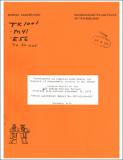Development of computer code models for analysis of subassembly voiding in the LMFBR : interim report of the MIT Sodium Boiling Project, covering work through September 30, 1979
Author(s)
Finkle, William Dean
DownloadEL_TR_1980_005.pdf (7.000Mb)
Metadata
Show full item recordAbstract
The research program discussed in this report was started in FY1979 under the combined sponsorship of the U.S. Department of Energy (DOE), General Electric (GE) and Hanford Engineering Development Laboratory (HEDL). The objective of the program is to develop multi-dimensional computer codes which can be used for the analysis of subassembly voiding incoherence under postulated accident conditions in the LMFBR. This work is expected to contribute to LMFBR safety analysis in two ways. First, it will provide a capability for obtaining more dependable information concerning the effects of subassembly voiding incoherence in LMFBR's of current design. Second, it will provide the calculational tools needed to develop new designs with features that could inhibit radial void growth and thus, enhance the reactor safety. Two codes are being developed in parallel. The first will use a two fluid (6 equation) model which is more difficult to develop but has the potential for providing a code with the utmost in flexibility and physical consistency for use in the long term. The other will use a "mixture" (< 6 equation) model which is less general but may be more amenable to interpretation and use of experimental data and therefore, easier to develop for use in the near term. To assure that the models developed are not design dependent, geometries and transient conditions typical of both foreign and U.S. designs are being considered. In addition to the code development, a study is being conducted which is aimed at obtaining a basic understanding of flow oscillations observed in low power, low flow sodium boiling experiments conducted at ORNL using the THORS test facility. This study includes water tests to simulate low power low flow sodium boiling flow oscillations and development of an analytical model to predict the oscillations. During FY1979 an effort has also been made to coordinate this program with other related DOE sponsored programs and activities concerned with sodium boiling R&D. The objectives of this effort are: (1) to assure maximum use is made of data and information available from related programs and (2) to facilitate eventual acquisition and use of the codes being developed by the appropriate DOE contractors and laboratories. This report describes work completed on each of the above tasks through September 30, 1979.
Date issued
1979Publisher
Cambridge : Massachusetts Institute of Technology, Energy Laboratory, 1979
Series/Report no.
Energy Laboratory report (Massachusetts Institute of Technology. Energy Laboratory) no. MIT-EL 80-005.
Keywords
Liquid metal fast breeder reactors